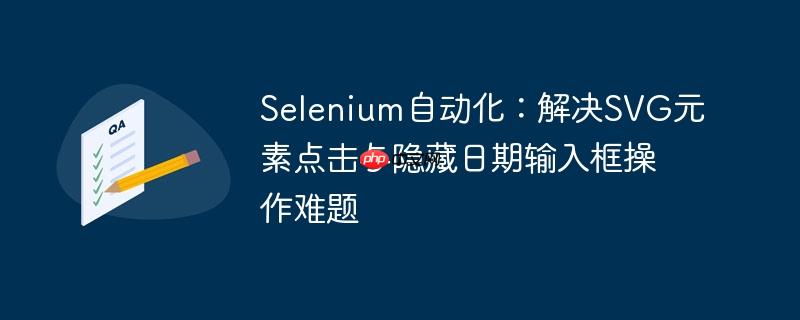
在使用selenium进行网页自动化时,开发者经常会遇到一些挑战,例如与非标准html元素(如svg)交互、处理弹窗或隐藏输入框。本文将针对一个典型的场景——自动化点击svg图标以打开日期选择器,并向隐藏的日期输入框中填入值——进行深入探讨,并提供一套完整的解决方案。
我们的目标是自动化以下操作:
在实际操作中,可能遇到以下问题:
为了成功实现上述自动化任务,我们需要分步解决这些问题。
许多网站在首次访问时会显示一个Cookie同意弹窗,如果不对其进行处理,后续的元素交互可能会被阻挡。因此,在进行任何其他操作之前,应首先尝试定位并点击Cookie同意按钮。
from selenium import webdriver
from selenium.webdriver.common.by import By
from selenium.webdriver.support.ui import WebDriverWait
from selenium.webdriver.support import expected_conditions as EC
# 初始化WebDriver (以Firefox为例)
driver = webdriver.Firefox()
# 打开目标网页
driver.get("https://www.investing.com/equities/tencent-holdings-hk-historical-data")
# 尝试点击Cookie同意按钮
# 检查页面上是否存在Cookie同意弹窗,并点击它
try:
cookie_accept_button = WebDriverWait(driver, 10).until(
EC.element_to_be_clickable((By.XPATH, "//*[@id='onetrust-accept-btn-handler']"))
)
cookie_accept_button.click()
print("成功点击Cookie同意按钮。")
except Exception as e:
print(f"未找到或未能点击Cookie同意按钮,或页面没有此弹窗。错误信息: {e}")
注意事项:
SVG(Scalable Vector Graphics)元素在HTML文档中通常有自己的XML命名空间。传统的XPath表达式(如//svg/g/path)在处理带有命名空间的SVG元素时可能会失败,导致TimeoutException。为了正确匹配这些元素,我们需要使用XPath的local-name()函数来忽略命名空间。
原始问题中的SVG路径是//*[@id='__next']/div[2]/div[2]/div[2]/div[1]/div[2]/div[2]/div[2]/div[2]/span/svg/g/path。为了兼容命名空间,应将其修改为:
# 等待SVG元素并点击
# 使用local-name()函数来处理SVG的命名空间问题
svg_element_xpath = "//*[@id='__next']/div[2]/div[2]/div[2]/div[1]/div[2]/div[2]/div[2]/div[2]/span/*[local-name()='svg']/*[local-name()='g']/*[local-name()='path']"
svg_element = WebDriverWait(driver, 10).until(
EC.element_to_be_clickable((By.XPATH, svg_element_xpath))
)
svg_element.click()
print("成功点击SVG日期图标。")关键点:
日期输入框可能设置了opacity-0或display: none等样式,使其在视觉上不可见。然而,Selenium的send_keys()方法通常仍然可以向这些元素发送文本,只要它们在DOM中存在且是可交互的。EC.visibility_of_element_located可以确保元素已加载到DOM中,即使它在视觉上是隐藏的。
# 找到日期输入框,清除现有值并设置新值
date_input = WebDriverWait(driver, 10).until(
EC.visibility_of_element_located((By.CSS_SELECTOR, "input[type='date']"))
)
date_input.clear()
date_input.send_keys("2020-01-01") # 输入目标日期
print("成功输入日期:2020-01-01。")提示:
在输入日期后,通常需要点击一个“应用”或“确定”按钮来确认更改。这与点击其他可点击元素类似。
# 找到并点击“Apply”按钮
apply_button = WebDriverWait(driver, 10).until(
EC.element_to_be_clickable((By.XPATH, "//button[text()='Apply']"))
)
apply_button.click()
print("成功点击'Apply'按钮。")为了验证上述操作是否成功,可以获取页面的最新源代码并进行检查。
# 打印页面源代码
page_source = driver.page_source.encode('utf-8').decode('utf-8')
print("\n--- 页面源代码 ---")
print(page_source[:2000]) # 打印前2000字符,避免输出过长
print("--- 页面源代码结束 ---\n")将上述所有步骤整合到一个完整的Python脚本中:
from selenium import webdriver
from selenium.webdriver.common.by import By
from selenium.webdriver.support.ui import WebDriverWait
from selenium.webdriver.support import expected_conditions as EC
import time
# --- 1. 初始化WebDriver ---
driver = webdriver.Firefox() # 或 Chrome(), Edge() 等
try:
# --- 2. 打开网页 ---
driver.get("https://www.investing.com/equities/tencent-holdings-hk-historical-data")
print("网页已打开。")
# --- 3. 处理Cookie同意弹窗 ---
try:
cookie_accept_button = WebDriverWait(driver, 15).until( # 增加等待时间,确保弹窗加载
EC.element_to_be_clickable((By.XPATH, "//*[@id='onetrust-accept-btn-handler']"))
)
cookie_accept_button.click()
print("成功点击Cookie同意按钮。")
time.sleep(2) # 等待弹窗关闭
except Exception:
print("未找到或未能点击Cookie同意按钮,或页面没有此弹窗。")
# --- 4. 等待并点击SVG日期图标 ---
# 使用local-name()函数处理SVG的命名空间问题
svg_element_xpath = "//*[@id='__next']/div[2]/div[2]/div[2]/div[1]/div[2]/div[2]/div[2]/div[2]/span/*[local-name()='svg']/*[local-name()='g']/*[local-name()='path']"
svg_element = WebDriverWait(driver, 10).until(
EC.element_to_be_clickable((By.XPATH, svg_element_xpath))
)
svg_element.click()
print("成功点击SVG日期图标。")
time.sleep(1) # 等待日期选择器弹出
# --- 5. 找到日期输入框,清除并输入新值 ---
# 即使元素opacity-0,只要在DOM中可见(visibility_of_element_located)即可交互
date_input = WebDriverWait(driver, 10).until(
EC.visibility_of_element_located((By.CSS_SELECTOR, "input[type='date']"))
)
date_input.clear()
date_input.send_keys("2020-01-01") # 输入目标日期
print("成功输入日期:2020-01-01。")
time.sleep(1) # 等待输入生效
# --- 6. 找到并点击“Apply”按钮 ---
apply_button = WebDriverWait(driver, 10).until(
EC.element_to_be_clickable((By.XPATH, "//button[text()='Apply']"))
)
apply_button.click()
print("成功点击'Apply'按钮。")
time.sleep(3) # 等待页面内容更新
# --- 7. 获取并打印页面源代码 ---
page_source = driver.page_source.encode('utf-8').decode('utf-8')
print("\n--- 页面源代码(部分)---")
print(page_source[:2000]) # 打印前2000字符
print("--- 页面源代码结束 ---\n")
except Exception as e:
print(f"自动化过程中发生错误: {e}")
# 打印完整的错误栈信息,有助于调试
import traceback
traceback.print_exc()
finally:
# --- 8. 关闭WebDriver ---
driver.quit()
print("WebDriver已关闭。")
通过掌握这些技巧,您将能够更有效地处理Selenium自动化中遇到的复杂网页元素交互问题,编写出更加稳定和可靠的自动化脚本。
以上就是Selenium自动化:解决SVG元素点击与隐藏日期输入框操作难题的详细内容,更多请关注php中文网其它相关文章!

每个人都需要一台速度更快、更稳定的 PC。随着时间的推移,垃圾文件、旧注册表数据和不必要的后台进程会占用资源并降低性能。幸运的是,许多工具可以让 Windows 保持平稳运行。

Copyright 2014-2025 https://www.php.cn/ All Rights Reserved | php.cn | 湘ICP备2023035733号